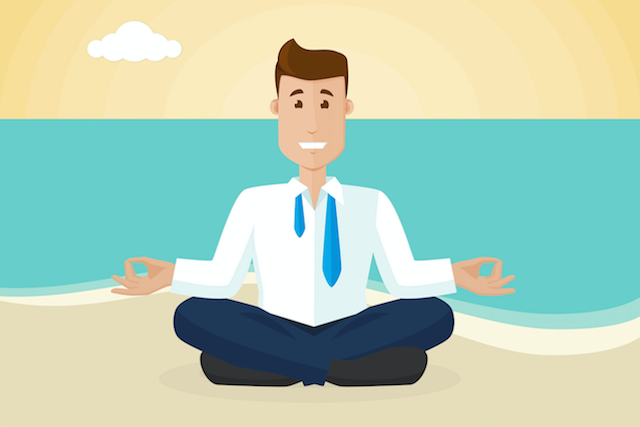
“It’s all about finding the calm in the chaos.” ~Donna Karan
Like my grandfather, I have always been a weather geek. I check the weather news daily and, for as long as I can remember, thunderstorms, warm/cold fronts, and clouds have fascinated me.
Close friends of mine will be the first to tell you that I have the bad habit of stopping someone mid-sentence to point out cirrus clouds, or a storm on the horizon.
But it’s more than just a nerdy interest. Looking at thunderstorms and clouds has always had a calming effect on me.
A few years ago I spent a summer in Edmonton, Canada, on my first extended work assignment abroad. It started well, but after a month I began receiving negative feedback from my client on the quality of work that I was submitting. Looking back, I realize there were power struggles going on in the background, and I was the scapegoat stuck in the middle.
But at the time it caused me a lot of stress, and each negative comment made me feel more and more like a failure.
At the end of one rough day in particular, I received another critical email from my client. On the drive home from the office I could feel my heart accelerating and hammers bashing on my forehead, signaling the onset of a stress-induced migraine.
My apartment sat high on a hill, and when I arrived home I happened to catch a glimpse of the outside view from the corner of my eye.
An enormous thunderstorm dominated the horizon; turbulent masses of air and water billowed high into the sky. The sunset was hitting the tops of the clouds at an angle that made the storm look like it was on fire. Hues of orange, red, and deep gray swirled into each other.
I was intrigued and stepped outside on my balcony to take a better look. I sat down on a chair and stayed there for at least an hour, watching churning clouds climb through the atmosphere and streaks of lightning flash through the flaming vapors.
As I sat there, with my eyes fixed on the spectacle before me, my heart rate and breathing slowed down, and the pounding in my head abated.
I knew that everything I was going through would pass and I felt at peace.
We all experience stress at one point. And because we have busy lives, we don’t always have the time to go running, or do yoga, or watch a funny movie to get rid of it.
Practicing mindfulness can be an effective alternative though. This pulls us into the present moment and can reduce our stress with minimal time and effort. Five ways we can use our surroundings to do this are to:
1. Sit quietly by a body of water.
Since mankind first came into existence, humans have used the calming effects of water to find peace. If you are stressed, find a river, a pond, an ocean—any body of water will do the trick. Try sitting next to the water and notice what your five senses are registering.
Listen to the sounds of the waves or the soft gurgles of the streaming water. Watch how the wind dances across the water, changing its surface into different shades of blue. Feel the wind on your face.
You might find that the cool water is able to carry your problems away with it.
2. Surround yourself with plants.
Another option for us is to spend a quiet moment in a green environment, whether it’s a park, a forest, a field, or our own backyard.
Use your senses and concentrate on how the sun feels on your face, or the ground underneath you. Smell the grass and plants. Listen to the birds and watch the various insects and other creatures go about their daily activities.
Surrounding ourselves with trees and grass can have a positive effect on our well-being by removing us from stressful urban environments. This gives us a chance to take deep breaths, reset our attention, and focus on the most important parts of our lives.
3. Look at the sky.
If you don’t have the time to find trees and water, just look up at the sky, wherever you happen to be. I’ve always loved watching thunderstorms, but the sky offers countless opportunities for us to sit back and take our minds off of our problems.
Spotting funny shapes in clouds is useful for expanding our own creativity. A good sunset, on the other hand, with its wide spectrum of colors, helps us appreciate the beauty of the world, even if we’ve had an awful day.
And at night the sky is lit up with the soft glow of the moon and the stars. These remind us that, in the grand scheme of things, our troubles are often a lot smaller than they feel at that particular moment.
4. Observe the people next to you.
Observing the people around us, however, can also be an effective method to take our minds off of a stressful situation.
I often use this technique in airports. It’s hilarious to watch parents try and corral their small children, who are always on a mission to explore every square inch of the terminal.
Or sometimes I pick a person walking by and create a backstory for them in my head. For example, I might imagine who they are, where they are from, and why they are in the airport at that moment.
It sounds strange, and it’s not the same as being in nature, but at least it can be entertaining and help us to think about something else.
5. Focus on the outside world.
When we are stuck in the office though, sometimes the best method for us is to spend a moment quietly observing the world outside of our windows. If you can see water, or trees, these can offer similar benefits as being in nature.
If you are in a high-rise building, and are surrounded by concrete and glass, try observing whatever is outside. Watch the cars driving by, the flashing lights of the billboards, or the people scurrying to and from work. This gives our brains a break and reminds us that we are not alone in our struggles.
—
Stress can come at inconvenient moments when we are unable to devote much time and energy to mitigate it. Using mindfulness to observe the world around us, even if only for a minute or two, can have immediate positive effects. .
It’s simple and free, so why not give it a try?
About John Nonemaker
John is an engineer and blogger living in the Netherlands. He writes to help left-brained thinkers and young professionals find moments of mindfulness amid the hustle and bustle of an active career. Connect with him and get more insight at www.johnnonemaker.com.












 Though I run this site, it is not mine. It's ours. It's not about me. It's about us. Your stories and your wisdom are just as meaningful as mine.
Though I run this site, it is not mine. It's ours. It's not about me. It's about us. Your stories and your wisdom are just as meaningful as mine. 